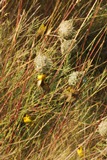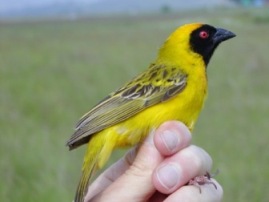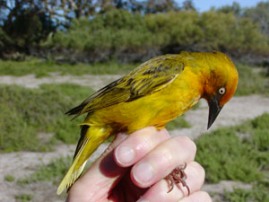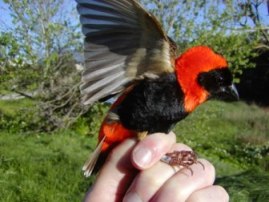Weaver news
| Bleiweiss R. 2014. Physical alignments between plumage carotenoid spectra and cone sensitivities in ultraviolet-sensitive (uvs) birds (Passerida: Passeriformes). Evolutionary Biology online.
Abstract. Among birds, single cone sensitivities responsible for color vision appear surprisingly conserved even though chromatic signals vary greatly. Thus it is widely held that avian visual signal and receptor characteristics are rarely aligned. Analysis of a diverse passerine clade (Passerida) with characteristically ultraviolet-sensitive (UVS) vision revealed that plumage carotenoid reflectance spectra matched cone maximal sensitivities at several levels: (1) plumage carotenoid reflectance minima and maxima in aggregate aligned with the four UVS single cones; (2) the corresponding reflectance features of yellow (hydroxy- and e-keto) and red (3- and 4-ß-keto) carotenoid classes aligned with different combinations of cones; (3) pairs of reflectance features (e.g. one minimum and one maximum) of each carotenoid class aligned with pairs of (opponent) cones that evoke chromatic perception; (4) passerid plumage carotenoids aligned more closely to their own (UVS) visual system than to the distinctive homologous cone classes
Carotenoid-based pigmentation provides an ideal system for exploring possible alignments between plumage reflectance and receptor
sensitivities. A total of 211 specimens from 80 species from three superfamilies
The weavers included in this study are: Baya Weaver, Dark-backed Weaver, Nelicourvi Weaver, Cape Weaver, Village Weaver, Southern Masked Weaver, Red Fody, Red-headed Quelea, Yellow Bishop, and Southern Red Bishop. Literature as featured in Weaver Watch news items |












 of the violet-sensitive system found in other birds. The ubiquitous occurrence of plumage carotenoids ipso facto demonstrates that alignments of avian visual signals and receptors are widespread, and provides novel evidence that carotenoids are important to avian communication. Moreover, alignment of different physical spectra to different cone combinations in a fixed receptor array provides a straightforward mechanism that accommodates signal diversity within the context of a relatively conserved visual system. The distinct patterns of variation and alignment observed for yellow versus red carotenoids further suggest that these pigment classes convey different physical aspects of content, which may foster carotenoid-based plumage diversity through signal design trade-offs.
of the violet-sensitive system found in other birds. The ubiquitous occurrence of plumage carotenoids ipso facto demonstrates that alignments of avian visual signals and receptors are widespread, and provides novel evidence that carotenoids are important to avian communication. Moreover, alignment of different physical spectra to different cone combinations in a fixed receptor array provides a straightforward mechanism that accommodates signal diversity within the context of a relatively conserved visual system. The distinct patterns of variation and alignment observed for yellow versus red carotenoids further suggest that these pigment classes convey different physical aspects of content, which may foster carotenoid-based plumage diversity through signal design trade-offs.
 (Sylvioidea, Muscicapoidea, Passeroidea) of Passerida were studied. Reflectance spectra were measured across the avian visible range (320-700 nm) including the ultraviolet (UV, <400 nm) for one to multiple individuals per sex per species. Each plumage patch was scored for the predominant carotenoid pigment present as indicated by recent compilations.
(Sylvioidea, Muscicapoidea, Passeroidea) of Passerida were studied. Reflectance spectra were measured across the avian visible range (320-700 nm) including the ultraviolet (UV, <400 nm) for one to multiple individuals per sex per species. Each plumage patch was scored for the predominant carotenoid pigment present as indicated by recent compilations.